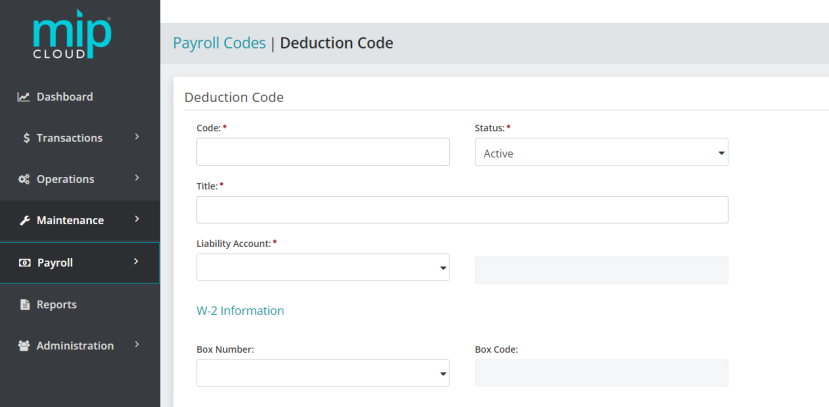Payroll Deduction Codes
Use this form to add a new Deduction Code or edit an existing one. The deduction codes entered are used throughout the system. The system uses deduction codes when it is calculating pay, creating an accounting entry for payroll, calculating and reporting W-2 information and other tax reports, and reporting.

The landing page when adding or editing a deduction code.
Click a dropdown link below to learn more about the fields in each section of the form.
| Code |
Enter a Deduction Code. You should make the first eight characters of the code unique so that the paycheck displays a useful identifier. We recommend limiting your entry to strictly alphabetic characters (A through Z) or numeric characters (0 through 9), and avoiding the use of symbols. |
| Status |
Specify the status of the code. The status can be changed at any time. Below are valid status entries and their descriptions:
|
| Title | Enter the title of the deduction Code. |
|
Liability Account |
Enter the General Ledger liability account for this code. The account must be an existing General Ledger account that is not a subledger-type account. The account must have a status of Active or Inactive. |
|
W-2 Information Box Number |
Select W-2 Box Number 7, 8, 10, 11, 12, or 14 if this code falls into one of those W-2 categories.
|
Choose a calculation method for this deduction code. The available methods are:
Fixed Percentage of Earnings: Select this method to determine deductions based on a percentage of earnings. The system first takes the total earning amount for just those earnings that are tied to the Deduction Code (as indicated on the "Earnings" tab). This earning amount is then multiplied by the percentage indicated in the "Percentage" box, to get a fixed percentage of earnings. Note that when using this calculation method, deductions vary with earnings.
Fixed Hourly Amount: Select this method to have the system base deductions on a fixed rate per hour worked. The system multiplies only the earning hours that are tied to the Deduction Code (as indicated on the "Earnings" tab), by the hourly amount specified in the "Amount" box. Note that when using this calculation method, deductions vary with hours worked.
Fixed Amount: Select this method when a deduction is based on a fixed amount per pay cycle. Enter a fixed deduction amount (in the "Amount" box) to calculate payroll.
Amount on Timesheet: Select this method to use the fixed amount, entered on the employee's timesheet, for deductions.
Percentage on Timesheet: Select this method to use a fixed percentage, entered on the employee's timesheet, for deductions.
Choose a calculation method, then fill out the following fields as required by the calculation method:
| Percentage |
Enter a percentage or amount, depending on the calculation method selected. You should enter a percentage for Fixed Percentage of Earnings, or an amount for Fixed Hourly Amount or Fixed Amount.
|
| Amount |
Enter a percentage or amount, depending on the calculation method selected. You should enter a percentage for Fixed Percentage of Earnings, or an amount for Fixed Hourly Amount or Fixed Amount. |
| Maximum per Year |
Enter the maximum amount allowed for deductions per calendar year. If there is no limit, enter a large number like 9,999,999,999 to be applied as the maximum. If the box is left at 0, 0 is applied as the maximum per year, and you will not get a benefit amount. |
|
Maximum Percentage |
Enter the maximum percentage allowed for a deduction, when "Percentage on Timesheet" is selected. When entering percentages include a decimal point. The percentage can range from zero to 100 percent. The system calculates up to four places to the right of the decimal point.
|
Note: This section is only available if the Fixed Percentage of Earnings, Fixed Hourly Amount, or Percentage on Timesheet calculation methods were selected.
Select the Earning Codes to use when calculating this deduction.
Any Earning Code set up with "Contribute to Net Pay Only" (see Payroll Earning Codes) is not available to use when calculating this deduction.
Assign a payroll schedule to the code. This schedule helps the system determine whether or not to use a particular deduction code when creating a Regular/Supplemental timesheet for an employee.
Note: A schedule is required for all cycles and payroll types (regular and supplemental). If no changes are made to this tab, the system uses the default, "Always".
| Monthly |
Choose from "Always" or "Never" for Regular and Supplemental Payroll. |
| Semimonthly |
|
| Biweekly |
|
|
Weekly |
|
Use this section to determine which federal, state, and other taxes to apply for this Deduction Code. When a checkbox is selected, the employee's earnings are decreased by the amount of the deduction for the selected tax.
Federal Taxes
Select Federal Income (FIT), Social Security, Medicare, and/or Federal Unemployment (FUTA), as appropriate for this code.
State Taxes
Select State Withholding Tax (SWT) and/or State Unemployment Tax (SUTA), as appropriate for this code.
Other Taxes
Select Employee Paid (LWT) and/or Employer Paid (LER), as appropriate for this code.
Note: For example, suppose your earnings are $1000. You create a non-taxable deduction of $200. Select all the check boxes for federal taxes on this tab. The federal taxable earnings would be $800. Since the state and other taxes are not selected, the taxable earnings for state and other taxes would be $1000.
When you are finished making your changes, click  .
.